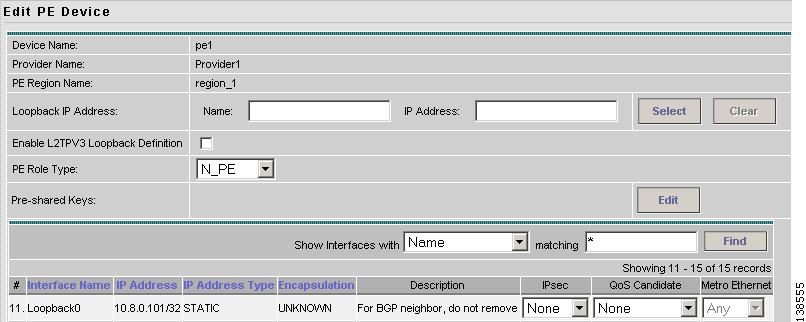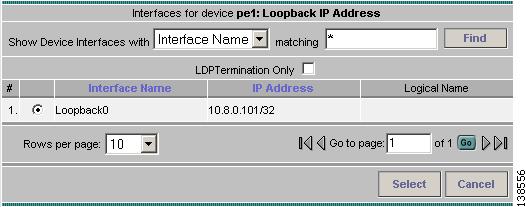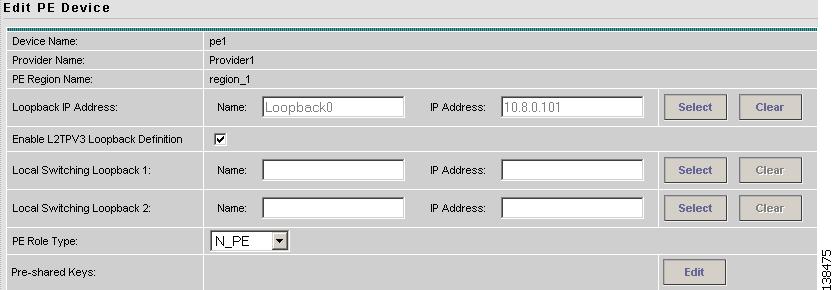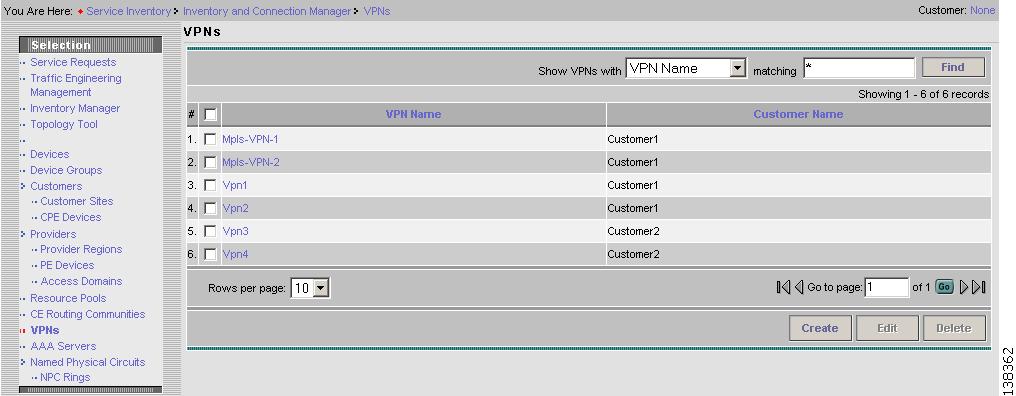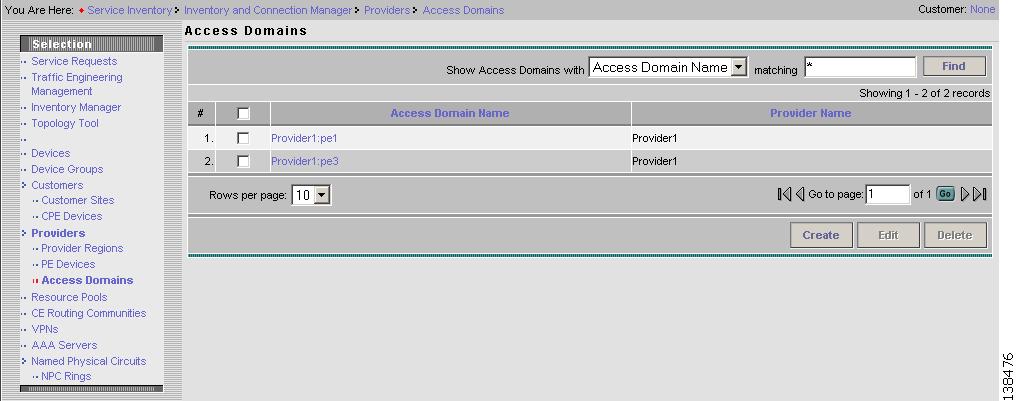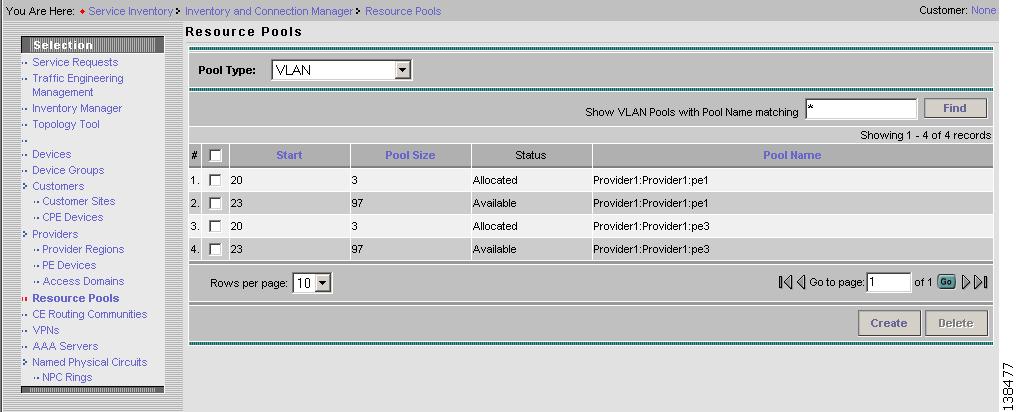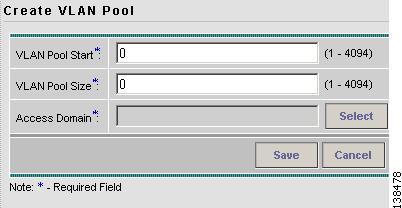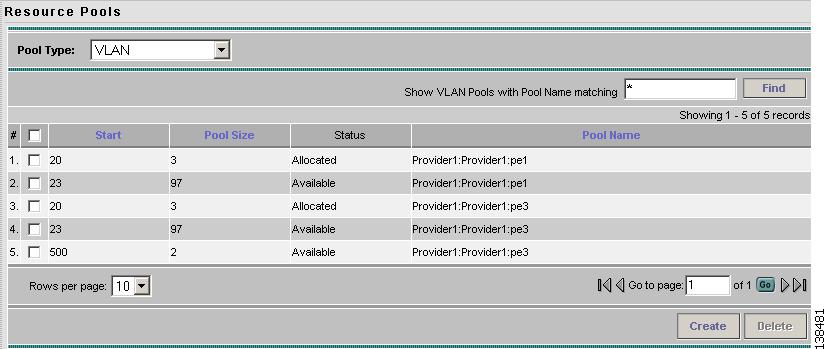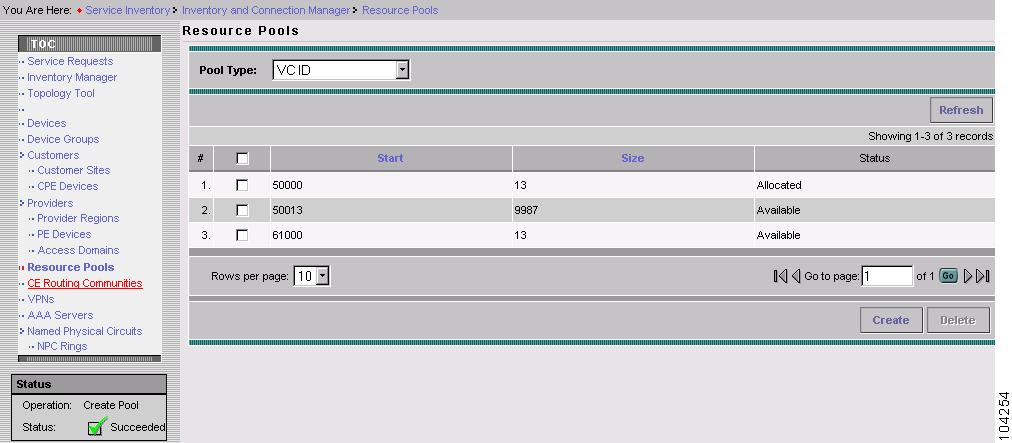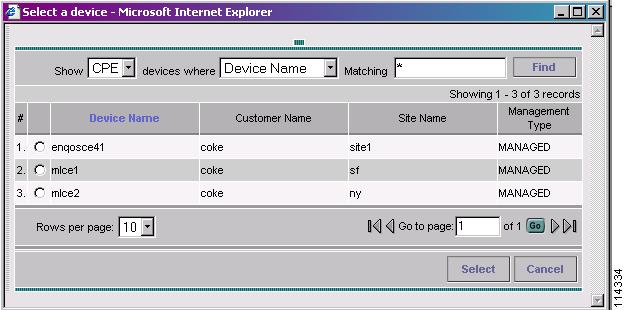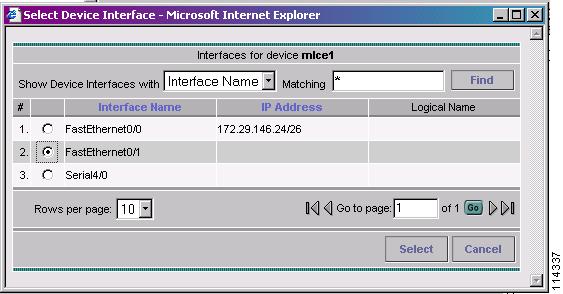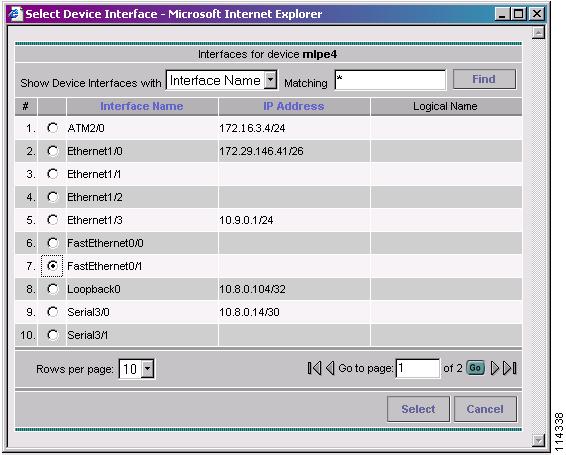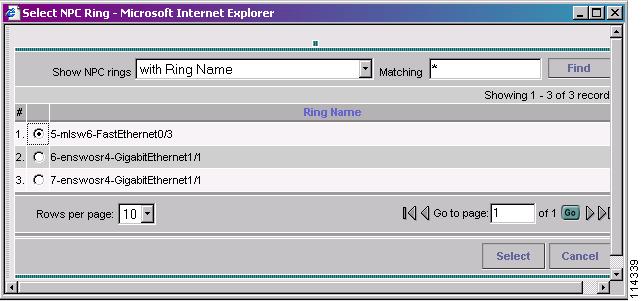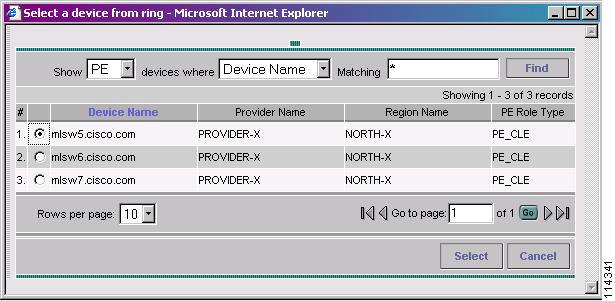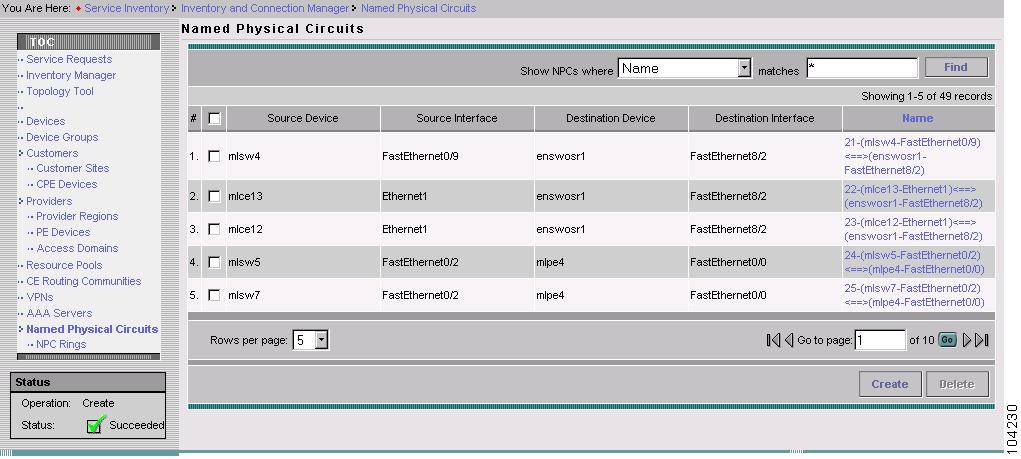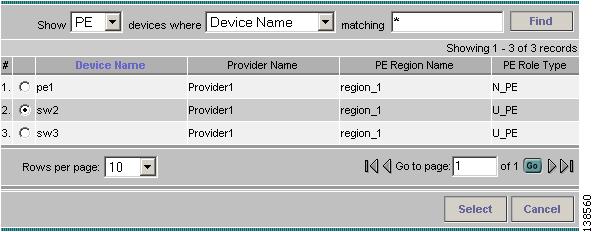

-
Cisco IP Solution Center L2VPN User Guide, 4.1
-
Index
-
About This Guide
-
Getting Started with L2VPN
-
ISC L2VPN and VPLS Concepts
-
Setting Up the ISC Service
-
Creating an L2VPN Policy
-
Managing an L2VPN Service Request
-
Creating an L2TPv3 Policy
-
Managing an L2TPv3 Service Request
-
Creating a VPLS Policy
-
Managing a VPLS Service Request
-
Using Autodiscovery for L2 Services
-
Generating L2 and VPLS Reports
-
Deploying, Monitoring and Auditing Service Requests
-
Setting Up VLAN Translation
-
Table Of Contents
Performing Device Settings to Support ISC
Configuring Switches in VTP Transparent Mode
Setting the Loopback Addresses on N-PE Devices
Creating Target Devices and Assign Roles (N-PE or U-PE)
Setting the L2TPv3 Local Switching Loopback
Defining a Service Provider and Its Regions
Defining Customers and Their Sites
Creating Named Physical Circuits
Creating NPCs Through an NPC GUI Editor
Creating NPC Links Through the Autodiscovery Process
Setting Up the ISC Service
You define the service-related elements, such as target devices, VPNs, and network links. Normally, you create these elements once. This chapter contains the basic steps to set up the Cisco IP Solution Center (ISC) service for an L2VPN, L2TPv3, or VPLS service. It contains the following sections:
•
Performing Device Settings to Support ISC
•
Creating Target Devices and Assign Roles (N-PE or U-PE)
•
Defining a Service Provider and Its Regions
•
Defining Customers and Their Sites
•
Creating Named Physical Circuits
Note
This chapter presents high-level information on ISC services that are relevant to L2VPN and VPLS. For more detailed information on setting up these and other basic ISC services, see Cisco IP Solution Center Installation Guide, 4.1.
Performing Device Settings to Support ISC
Two device settings must be configured to support the use of ISC in the network:
•
Switches in the network must be operating in VTP transparent mode.
•
Loopback addresses must be set on N-PE devices.
Note
These are the two minimum device settings required for ISC to function properly in the network. You must, of course, perform other device configuration steps for the proper functioning of the devices in the network.
Configuring Switches in VTP Transparent Mode
For security reasons, ISC requires VTPs to be configured in transparent mode on all the switches involved in ERS or EWS services before provisioning L2VPN service requests. To set the VTP mode, enter the following Cisco IOS commands:
Switch# configure terminalSwitch(config)# vtp mode transparentEnter the following Cisco IOS command to verify that the VTP mode has changed to transparent:
Switch# Show vtp statusSetting the Loopback Addresses on N-PE Devices
See the section "Setting the Loopback Address" section for information.
Creating Target Devices and Assign Roles (N-PE or U-PE)
Every network element that ISC manages must be defined as a device in the system. An element is any device from which ISC can collect information. In most cases, devices are Cisco IOS routers that function as N-PE, U-PE, and P.
For detailed steps to create devices, see Cisco IP Solution Center Infrastructure Reference, 4.1.
Setting the Loopback Address
The loopback address for the N-PE has to be properly configured for an AToMPLS connection. The IP address specified in the loopback interface must be reachable from the remote pairing PE. The LDP tunnels are established between the two loopback interfaces of the PE pair.
See Figure 3-1 for an example of a loopback address.
Figure 3-1 PE Loopback Address
To prevent a wrong loopback address being entered into the system, the loopback IP address field on the GUI is read only. You choose the loopback address with the help of a separate pop-up window, which you access by clicking the Select button. This ensures that you will select only a valid loopback address defined on the device. See Figure 3-2.
Figure 3-2 Select Device Interface
This feature ensures that a valid loopback address is set.
To further narrow the search, you can select the LDPTermination Only check box and click the Select button. This will then limit the list to the LDP-terminating loopback interface(s).
Setting the L2TPv3 Local Switching Loopback
Local switching requires that you select two loopback addresses. Each loopback must be unique. To set a second loopback address, select the Enable L2TPV3 Loopback Definition check box. See Figure 3-3.
Figure 3-3 PE Local Switching Loopback Addresses
This causes two additional GUI fields to appear, Local Switching Loopback 1 and Local Switching Loopback 2. Use the Select button to set the local switching loopbacks.
Defining a Service Provider and Its Regions
You must define the service provider administrative domain before provisioning L2VPN. The provider administrative domain is the administrative domain of an ISP with one BGP autonomous system (AS) number. The network owned by the provider administrative domain is called the backbone network. If an ISP has two AS numbers, you must define it as two provider administrative domains. Each provider administrative domain can own many region objects.
For detailed steps to define the provider administrative domain, see Cisco IP Solution Center Infrastructure Reference, 4.1.
Defining Customers and Their Sites
You must define customers and their sites before provisioning L2VPN. A customer is a requestor of a VPN service from an ISP. Each customer can own many customer sites. Each customer site belongs to one and only one Customer and can own many CPEs. For detailed steps to create customers, see Cisco IP Solution Center Infrastructure Reference, 4.1.
Defining VPNs
You must define VPNs before provisioning L2VPN or VPLS. In L2VPN, one VPN can be shared by different service types. In VPLS, one VPN is required for each VPLS instance.
To create a VPN, perform the following steps.
Step 1
Select Service Inventory > Inventory and Connection Manager.
Step 2
Click VPNs in the left column. The VPNs window appears as shown in Figure 3-4.
Figure 3-4 Defining a VPN
For detailed steps to create VPNs, see Cisco IP Solution Center Infrastructure Reference, 4.1.
Note
The VPN in L2VPN is only a name used to group all the L2VPN links. It has no intrinsic meaning as it does for MPLS VPN.
Creating Access Domains
For L2VPN and VPLS, you create an Access Domain if you provision an Ethernet-based service and want ISC to automatically assign a VLAN for the link from the VLAN pool.
Note
You do not create an access domain for L2TPv3.
For each Layer 2 access domain, you need a corresponding Access Domain object in ISC. During creation, you select all the N-PE devices that are associated with this domain. Later, one VLAN pool can be created for an Access Domain. This is how N-PEs are automatically assigned a VLAN. See Figure 3-5.
Before you begin, be sure that you:
•
Know the name of the access domain that you want to create.
•
Have created a service provider to associate with the new access domain.
•
Have created a provider region associated with your provider and PE devices.
•
Have created PE devices to associate with the new access domain.
•
Know the starting value and size of each VLAN to associate with the new access domain.
•
Know which VLAN will serve as the management VLAN.
To create an Access Domain, perform the following steps.
Step 1
Select Service Inventory > Inventory and Connection Manager.
Step 2
Click Access Domains in the left column. The Access Domains window appears as shown in Figure 3-5.
Figure 3-5 Create an Access Domain
The Access Domains window contains the following:
•
Access Domain Name Lists the names of access domains. The first character must be a letter. The name can contain letters, numbers, and these punctuation characters: period, underscore, and dash. Limit: 80 characters. You can sort the list by access domain name.
•
Provider Name Lists the names of providers. Must begin with a letter. Can contain letters, numbers, and these punctuation characters: period, underscore, and dash. Limited to 80 characters. You can sort the list by provider name.
•
From the Access Domains window, you can create, edit, or delete access domains using the following buttons:
–
Create—Click to create new access domain. Enabled only if you do not select an access domain.
–
Edit—Click to edit the selected access domain (select by clicking the corresponding box). Enabled only if you select a a single access domain.
–
Delete—Click to delete the selected access domain (select by clicking the corresponding box). Enabled only if you select one or more access domains.
Creating VLAN Pools
For L2VPN and VPLS, you create a VLAN pool so that ISC can assign a VLAN to the links. VLAN ID pools are defined with a starting value and a size of the VLAN pool. A VLAN pool can be attached to an access domain. During the deployment of an Ethernet service, VLAN IDs can be auto-allocated from the access domain's pre-existing VLAN pools. When you deploy a new service, ISC changes the status of the VLAN pool from Available to Allocated. Auto-allocation gives the service provider tighter control of VLAN ID allocation.
You can also allocate VLAN IDs manually.
Note
When you are setting a manual VLAN ID on an ISC service, ISC warns you if the VLAN ID is outside the valid range of the defined VLAN pool. If so, ISC does not include the manually defined VLAN ID in the VLAN pool. We recommend that you preset the range of the VLAN pool to include the range of any VLAN IDs that you manually assign.
Note
For L2TPv3, you do not create a VLAN pool.
Create one VLAN pool per access domain. Within that VLAN pool, you can define multiple ranges.
Before you begin, be sure that you:
•
Know each VLAN pool start number.
•
Know each VLAN pool size.
•
Have created an access domain for the VLAN pool (see Creating Access Domains).
•
Know the name of the access domain to which each VLAN pool will be allocated.
Perform these steps if you want to have ISC automatically assign a VLAN to the links.
Step 1
Select Service Inventory.
Step 2
Select Inventory and Connection Manager.
Step 3
Select Resource Pools. The Resource Pools window appears.
Step 4
Select VLAN from the drop-down Pool Type list as shown in Figure 3-6.
Figure 3-6 VLAN Resource Pools
Step 5
Click Create. The Create VLAN Pool window appears as shown in Figure 3-7.
Figure 3-7 Create VLAN Pool
Step 6
Enter a VLAN Pool Start number.
Step 7
Enter a VLAN Pool Size number.
Step 8
If the correct access domain is not showing in the Access Domain field, click Select to the right of Access Domain field.
The Access Domain for New VLAN Pool dialog box appears as shown in Figure 3-8.
If the correct access domain is showing, continue with Step 9.
Figure 3-8 Access Domain for New VLAN Pool
a.
Select an Access Domain Name by clicking the button in the Select column to the left of that Access Domain.
b.
Click Select. The updated Create VLAN Pool window appears as shown in Figure 3-9.
Figure 3-9 Updated Create VLAN Pool
Step 9
Click Save.
The updated VLAN Resource Pools window appears as shown in Figure 3-10.
Note
The pool name is created automatically, using a combination of the provider name and the access domain name.
Note
The Status field reads "Allocated" if you already filled in the Reserved VLANs information when you created the access domain. If you did not fill in the Reserved VLANs information when you created the access domain, the Status field reads "Available." To allocate a VLAN pool, you must fill in the corresponding VLAN information by editing the access domain. (See Creating Access Domains.) The VLAN pool status automatically sets to "Allocated" on the Resource Pools window when you save your work.
Figure 3-10 Updated VLAN Resource Pools
Step 10
Repeat this procedure for each range you want to define within the VLAN.
Creating a VC ID Pool
VC ID pools are defined with a starting value and a size of the VC ID pool. A given VC ID pool is not attached to any inventory object (a provider or customer). During deployment of an L2VPN or VPLS service, the VC ID can be auto-allocated from the same VC ID pool or you can set it manually.
Note
When you are setting a manual VC ID on an ISC service, ISC warns you if the VC ID is outside the valid range of the defined VC ID pool. If so, ISC does not include the manually defined VC ID in the VC ID pool. We recommend that you preset the range of the VC ID pool to include the range of any VC IDs that you manually assign.
Create one VC ID pool per network.
In a VPLS instance, all N-PE routers use the same VC ID for establishing emulated Virtual Circuits (VCs). The VC-ID is also called the VPN ID in the context of the VPLS VPN. (Multiple attachment circuits must be joined by the provider core in a VPLS instance. The provider core must simulate a virtual bridge that connects the multiple attachment circuits. To simulate this virtual bridge, all N-PE routers participating in a VPLS instance form emulated VCs among them.)
Note
VC ID is a 32-bit unique identifier that identifies a circuit/port.
Before you begin, be sure that you have the following information for each VC ID pool you must create:
•
The VC Pool start number
•
The VC Pool size
Perform these steps for all L2VPN and VPLS services.
Step 1
Select Service Inventory.
Step 2
Select Inventory and Connection Manager.
Select Resource Pools. The Resource Pools window appears.
Step 3
Select VC ID from the drop-down Pool Type list as shown in Figure 3-11. Because this pool is a global pool, it is not associated with any other object.
Figure 3-11 VC ID Resource Pools
Step 4
Click Create. The Create VC ID Pool window appears as shown in Figure 3-12.
Figure 3-12 Create VC ID Pool
Step 5
Enter a VC pool start number.
Step 6
Enter a VC pool size number.
Step 7
Click Save. The updated VC ID Resource Pools window appears as shown in Figure 3-13.
Figure 3-13 Updated VC ID Resource Pools
Creating Named Physical Circuits
Before creating an L2VPN, L2TPv3, or VPLS service request, you must predefine the physical links between CEs and PEs. The Named Physical Circuit (NPC) represents a link going through a group of physical ports. Thus, more than one logical link can be provisioned on the same NPC; therefore, the NPC is defined once but used during several L2VPN or VPLS service request creations.
There are two ways to create the NPC links:
•
Through an NPC GUI editor.
•
Through the autodiscovery process.
An NPC definition must observe the following creation rules:
•
An NPC must begin with a CE or an up-link of the device where UNI resides or a Ring.
•
An NPC must end with an N-PE or a ring that ends in an N-PE.
If you are inserting NPC information for a link between a CE and UNI, you enter the information as:
•
Source Device is the CE device.
•
Source Interface is the CE port connecting to UNI.
•
Destination Device is the UNI box.
•
Destination interface is the UNI port.
If you are inserting NPC information for a CE not present case, you enter the information as:
•
Source Device is the UNI box.
•
Source Interface is the UP-LINK port, not the UNI port, on the UNI box connecting to the N-PE or another U-PE or PE-AGG.
•
Destination Device is the U-PE, PE-AGG, or N-PE.
•
Destination Interface is the DOWN-LINK port connecting to the N-PE or another U-PE or PE-AGG.
If you have a single N-PE and no CE (no U-PE and no CE), you do not have to create an NPC since there is no physical link that needs to be presented.
If an NPC involves two or more links (three or more devices), for example, it connects ence11, enpe1, and enpe12, you can construct this NPC as follows:
•
Build the link that connects two ends:mlce1 and mlpe4 (as shown in Figure 3-25).
•
Insert a device (enpe12) to the link you just made.
•
Click Insert Device to insert the device.
Creating NPCs Through an NPC GUI Editor
Perform the following steps to create NPCs through the NPC GUI editor.
Step 1
Select Service Inventory
Step 2
Select Inventory and Connection Manager
Step 3
Select Named Physical Circuits. The Named Physical Circuits window appears as shown in Figure 3-14.
Figure 3-14 Named Physical Circuit
To create a new NPC, you choose a CE as the beginning of the link and a N-PE as the end. If more than two devices are in a link, you can add or insert more devices (or a ring) to the NPC. Note that the new device or ring added is always placed after the device selected, while a new device or ring inserted is placed before the device selected.
Each line on the Point-to-Point Editor represents a physical link. Each physical link has five attributes:
•
Source Device
•
Source Interface
•
Destination Device (must be a N-PE)
•
Destination Interface
•
Ring
Note
Before adding or inserting a ring in an NPC, you must create a ring and save it in the repository. To obtain information on creating NPC rings, see Cisco IP Solution Center Infrastructure Reference, 4.1.
Source Device is the beginning of the link and Destination Device is the end of the link.
In the following example, there is a link with one end connecting a device called mlce1 on interface Ethernet0/0 and another link connecting to mlpe4 on interface FastEthernet0/0. Use the following steps to enter these devices.
Step 4
Click Create.
The Create a Named Physical Circuit window appears. See Figure 3-15.
Figure 3-15 Create a Named Physical Circuit
Step 5
Click Add Device. A list like the one in Figure 3-16 appears.
Figure 3-16 Choose a CPE
Step 6
Choose a CPE as the beginning of the link.
Step 7
Click Select. The device appears as shown in Figure 3-17.
Figure 3-17 Device Selected for NPC
Step 8
To insert another device or a ring, click Insert Device or Insert Ring. To add another device or ring to the NPC, click Add Device or Add Ring.
For this example, click Add Device to add the N-PE.
Step 9
Choose a N-PE as the destination device.
Step 10
Click Select. The device appears as shown in Figure 3-18.
Figure 3-18 Second Device Selected for NPC
Step 11
In the Outgoing Interface column, click Select outgoing interface.
A list of interfaces, similar to the one in Figure 3-19, that were entered into the system appears.
Figure 3-19 Select Outgoing Interface
Step 12
Choose an interface from the list and click Select.
Step 13
In the Incoming Interface column, click Select incoming interface.
A list of interfaces, similar to the one in Figure 3-20, that were entered into the system appears.
Figure 3-20 Select Incoming Interface
.
Step 14
Choose an interface from the list as the end of the link and click Select.
If you did not create a ring that you want to insert into the NPC, go to Step 25.
Step 15
If you created a ring to be used with the NPC, click Add Ring or Insert Ring. The Select NPC Ring window appears as shown in Figure 3-21.
Note
For L2TPv3, you cannot create rings.
Figure 3-21 Select NPC Ring
Step 16
Select a Ring Name and click Select. The Create a Named Physical Circuit window appears similar to the one in Figure 3-22.
Figure 3-22 Create a Named Physical Circuit
Step 17
Click Select device.
Step 18
Select a Device from the ring to connect to mlce1 from a window like the one in Figure 3-23 and click Select.
Figure 3-23 Select a Device from the Ring
Step 19
Click Select incoming interface.
Step 20
Select the Interface and click Select.
Step 21
Click Select device.
Step 22
Select a Device from the ring to connect to mlpe4 from a window like the one in Figure 3-23 and click Select.
Step 23
Click Select outgoing interface.
Step 24
Select the Interface and click Select.
The NPC that includes the ring is now complete as shown in Figure 3-24.
Figure 3-24 Ring Complete
Step 25
Click Save. The Named Physical Circuits window now displays the NPC that you created as shown in Figure 3-25.
Figure 3-25 Created NPC
Creating a Ring-Only NPC
You can also create an NPC that contains only a ring without specifying CE.
Step 1
Select Service Inventory > Inventory and Connection Manager > Named Physical Circuits.
Step 2
Click Create.
Step 3
The Create a Named Physical Circuit window appears, appears as shown in Figure 3-26.
Figure 3-26 Create an NPC that is a Ring
Step 4
Click Add Ring. The Select NPC Ring window (Figure 3-27) appears.
Figure 3-27 Select a Ring
Step 5
Select a ring and click Select. The ring appears in a window like the one in Figure 3-28.
Figure 3-28 Select Device
Step 6
Click the Select device link to select the beginning of the ring. A window appears like the one in Figure 3-29, showing a list of devices.
Figure 3-29 Select the Beginning of the Ring
Step 7
Choose the device that is the beginning of the ring and click Select.
Step 8
Click the Select device link to choose the end of the ring.
Step 9
Choose the device that is the end of the ring and click Select.
Note
The device that is the end of the ring in a ring-only NPC must be an N-PE.
Step 10
The Create a Named Physical Circuit window appears (Figure 3-30) showing the Ring-Only NPC.
Figure 3-30 Ring-Only NPC
Step 11
Click Save to save the NPC to the repository.
Creating NPC Links Through the Autodiscovery Process
With autodiscovery, the existing connectivity of network devices can be automatically retrieved and stored in the ISC database. NPCs are further abstracted from the discovered connectivity.
For detailed steps to create NPCs using autodiscovery, see Cisco IP Solution Center Infrastructure Reference, 4.1.

 Feedback
Feedback
